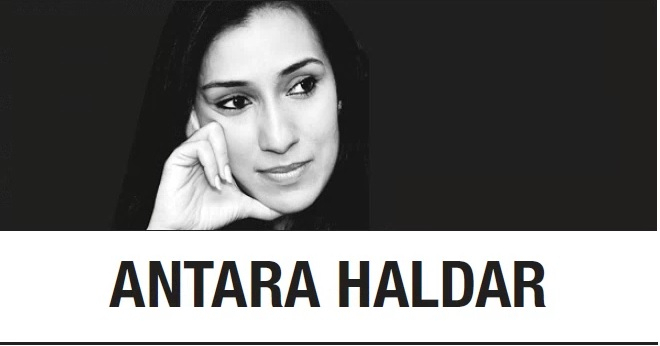
William Shakespeare’s 1597 comedy “Love’s Labor’s Lost” tells the story of four Frenchmen as they navigate the tension between commitment to intellectual development and the quest for domestic bliss. Some four centuries later, Harvard economist Claudia Goldin reimagined the tale from the vantage point of American women balancing career and family. Now, Goldin’s profound insights into women’s labor-market outcomes have won her a Nobel Memorial Prize in Economic Sciences.
Goldin’s achievement is notable not only because she works in an overwhelmingly male-dominated discipline -- she is only the third woman in history to win the economics Nobel, and the first to win it solo -- but also because her scholarship focuses squarely on gender. The issues Goldin researches -- women’s labor-force participation and, specifically, the gender pay gap -- are typically siloed within feminist economics and marginalized in the field.
Goldin, who positions herself as an “economist-detective,” has cracked a number of cases, but as the committee for the prize noted, three stand out. First, most theories of economic development assumed that, as economies grew, women would automatically and frictionlessly be pulled into the workforce. But Goldin’s research shows that female labor-force participation over time follows a U-shaped curve.
Meticulously combing 200 years’ worth of data, Goldin observed that as the locus of economic activity moves from agriculture to industry, female labor-force participation falls, owing largely to the challenge of balancing child care with factory work, especially for married women. But once the service sector gains dominance, women join the workforce at much higher rates.
Second, the gender pay gap -- women on average make 77 cents for every dollar earned by men in the US -- has traditionally been attributed to myriad factors, from educational attainment to differences in ambition. Some claim that it is a matter of aptitude: former US Treasury Secretary Lawrence Summers, for example, argued in 2005 that men are biologically better suited to math and science.
But, by examining differences in pay within the same occupation, Goldin showed that the actual explanation is much simpler. As it turns out, the ongoing lag cannot be attributed to educational attainment; in rich countries, women have overtaken men on this front. And since the pay gap exists within professions, it cannot be attributed to women’s higher representation in less lucrative fields. Nor can cognitive ability be the problem, given that pay for men and women is almost identical at university graduation.
Rather, women earn less than men due to the brute biological fact of childbirth. The pay gap starts to emerge a year or two after the birth of a woman’s first child. By age 45, women earn 55 percent what men do, owing to childbirth-related factors like career interruptions and reductions in working hours.
Third, Goldin’s research establishes that women’s expectations of their prospects matter. Because of the “demonstration effect” -- that is, the example set by their mothers and grandmothers -- they long sold themselves short professionally. This began to change in the US in the 1970s, with rising investment in female education and delays in marriage and childbirth.
In a working paper published on the morning of her Nobel win, Goldin highlights a series of developments between 1963 and 1973 that laid the groundwork for this shift. These include the passage of the Equal Pay Act, Roe v. Wade (when the US Supreme Court recognized a constitutional right to abortion), an increase in Ivy League admissions for women and, especially, access to oral contraceptives.
Goldin’s scholarship holds a number of important lessons for economics. It illustrates the centrality of history to understanding today’s economic realities (a fitting tribute to Goldin’s mentor and fellow Nobel laureate Robert Fogel). There are persistent problems and inefficiencies that markets have failed to solve, even over the course of centuries. Why are women still paying such a high price for providing children, a public good par excellence?
Goldin’s scholarship also demonstrates the need to disaggregate economic agents, because outcomes often reflect self-fulfilling prophecies based on identity, social structures, and subjective perceptions. For example, as Goldin explains, most similarly educated heterosexual couples do not split domestic duties evenly, because the male partner typically earns more. But this reinforces the pay differential.
Most radically, Goldin’s work shows that economics inhabits not only formal institutional spaces, but also intimate ones. The discipline should be as concerned with marriage markets as it is with financial markets. The bedroom is no less relevant than the boardroom. Ideas that have long been addressed in women’s magazines belong in economic journals.
Goldin’s work underscores a point that feminists have long emphasized: women do not have the luxury of separating the personal from the professional. Economics cannot afford to ignore the reality that for women, domestic bliss comes with a price tag attached, in terms of both income and independence.
From a policy perspective, we have two options. We can reimagine marriage and child-rearing to ensure that women can compete in an economic system built for men, such as by introducing workplace childcare and making use of tax incentives. Or, as Goldin advocates, we can reimagine the economy so that it works for women, making it more flexible, less “greedy,” and more focused on empathy. If we do nothing, however, love’s labor will continue to be women’s loss.
Antara Haldar
Antara Haldar, a professor of empirical legal studies at the University of Cambridge, is a visiting faculty member at Harvard University. -- Ed.
(Project Syndicate)







![[Today’s K-pop] Blackpink’s Jennie, Lisa invited to Coachella as solo acts](http://res.heraldm.com/phpwas/restmb_idxmake.php?idx=644&simg=/content/image/2024/11/21/20241121050099_0.jpg)